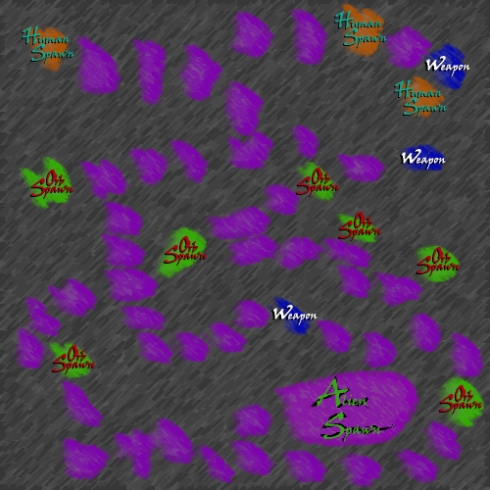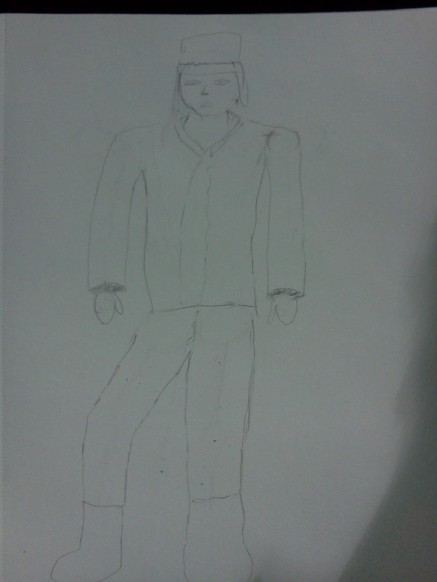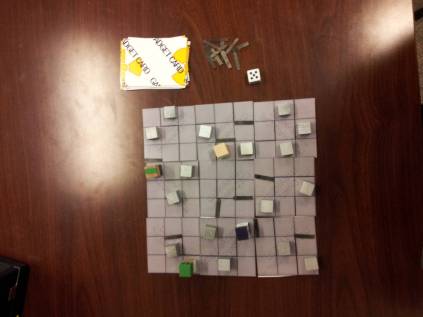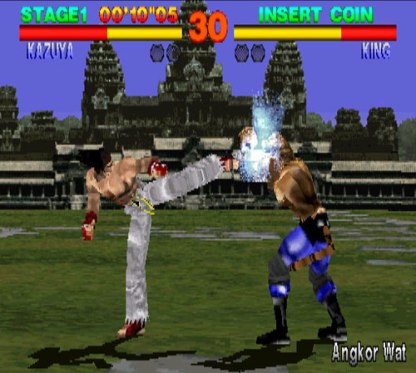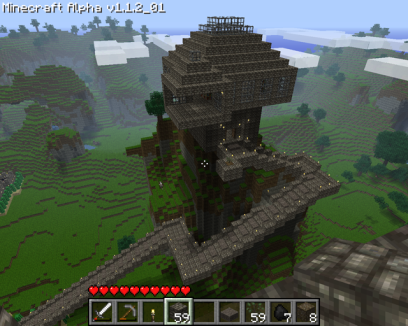Author Archives: bassemtodary
Market Race: A Farming Game
Bassem Todary – 100425868
Our game is a card game that is centred on the premise of the farmer’s market of Ontario.
We take into account which fruits and vegetables are in season in certain months over the year; it is a speedy card game in which you play as a farmer trying to harvest the best crops in the months you are given:
Contents:
- 30 Fruits and Vegetable Cards
- 30 Month Cards
- 1 Reference Table
- 1 Timer
Set Up:
1) Shuffle the deck
2) Deal out 5 cards to each player
3) Place the rest of the cards face down in the center of the four players and spread them out to make a pile
4) Set and start the timer
Game play:
- There are no turns; all players start at the same time.
- Players must match the fruits and vegetable cards to the corresponding month that they are available in to make a pair.
- Once a pair has been made, the player must place the pair face up in front of them.
- Each fruit or vegetable must only be matched to one of the corresponding months. For example, pears are available August through November, but the player can choose any month in that time frame and match their pear card to any month.
- Players may pick up cards from the pile and place them in their hand, but they must match them to release them.
- A player may also discard a card from their hand, but in turn must pick up 2 cards from the pile.
- The goal is to match all the cards in your hand before the time runs out.
- The winner of the game is the player who matches all their cards before time runs out. If no players have matched all their cards before time runs out, the winner is the player who made the most pairs.
The game was not too difficult to make, it just took a bit of research and creating the cards was not too hard either. If you are going into this game, it can useful to have some knowledge of the harvest seasons since this game relies on speed.
Bollywood Boogie – A Chaiyaa Chaiyaa dance party for everyone
Chaiyya Chaiyya is a Hindi song from the 1998 Hindi film Dil Se.. directed by Mani Ratnam. The song was composed by A.R. Rahman, written by Gulzar, and sung by Sukhwinder Singh and Sapna Awasthi. It quickly became popular upon release and its music video gained the same status, partly because it was filmed on a moving train.
The lyrics of Chaiyya Chaiyya are based on the Sufi folk song Thaiyya Thaiyya with lyrics written by poet Bulleh Shah. Singer Sukhwinder Singh originally suggested the song to A.R. Rahman who was looking for a Punjabi devotional song to include on the soundtrack of Dil Se… Gulzar subsequently rewrote the lyrics and changed the name to Chaiyya Chaiyya.
Our game is a dance party that is dedicated to this song, along with a few other popular songs such as Jai Ho composed by A. R. Rahman for the film Yuvvraaj, and Ghoonghat Ohle Na Luk Sajna Abida. As a bonus we include Tanuk Tanuk Ta.
For each song, you listen to the music and follow the dance steps that are instructed to you on screen. We have also included difficulty levels which are distinguished by the decreasing the amount of time allowed to execute a dance move and including more to do such as having the player freeze in place or to jump or even sing along.
The difficulty levels each have the own song, from easiest to hardest is Jai Ho, Chaiyya Chaiyya, Ghoonghat Ohle Na Luk Sajna Abida and the bonus track Tanuk Tanuk Ta.
The rules are:
– Everyone who’s playing spread across the playing area, make sure everyone has arm room and can see the screen.
– Players select another player to be judge, who does not participate in the dancing but keeps track of people who should be out. Most of the decisions are up to the judge’s discretion.
– No one is allowed to make physical contact with one another; if they do they are out.
– The Judge Player selects level difficulty, or by player consensus.
– Follow the dance poses on the screen and instructions, if they fail to do so before it changes, they are out.
– A person can choose to stop playing, they are out however.
– Last person standing wins or the people remaining after the song is done win.
Going into this project, I was worried about how the game will be made since the premise of making a game based off a dance move doesn’t allow for much to do in terms of variation, a problem which plague a lot of other people’s prototypes. However it did turn out to be fairly fun despite not being fond of dancing myself.
Our Jane Austen pirate board game adaptation: Northanger Abbey Deathmatch
This game is loosely based on the novel Northanger Abbey by revered author Jane Austen. It takes place within Henry and Catherine’s imagination. Our game is based on a part of the book where Catherine is excited about being able to see a real abbey and Henry adds to her excitement by creating a story about this a mystical gothic place filled with secret passages and mysterious chests. Here’s the twist we added pirates to the game which would accompany Henry and Catherine in the imaginary abbey to sprawl for treasure as the two’s enemies. This brings us to the idea for our game which is a battle between our heroes and the dreaded pirates.
The rules are a bit plentiful but with explanation and experience you’ll quickly understand it.
Movement is determined by a dice roll and the game requires 2 teams of two people or 2 opposing players. One team is the hero team consisting of Henry and Catherine, the other is the pirates.
The player piece that represent the pirates.
The heroes are represented by cut outs of these two characters.
There are many secret passages in the game; in order to enter one of them you must roll the specific number that on the die. After fulfilling this requirement you then follow the path of the passage to your new position.
Chests are found in side passages on the map. They contain bonuses but are guarded by ghosts. To defeat a ghost you must perform a battle sequence. This consists of first rolling the die for the ghost. This number constitutes its strength. Then in order to beat it you must roll higher than its strength. After you defeat the ghost you obtain the item from the chest.
Chests will contain either a positive or a negative bonus card. Positive ones are what you would expect extra dice roll, extra movement spaces etc. Negative cards however have a more strategic role. Once you get a negative card you put it into your own negative card pile. To add a sense of strategy negative cards are not used on your next turn but are instead called upon by your opponents. For example, say the person playing as henry got a negative card from his chest that reduced his roll by 2.
The game board during productionuring production.
This card would not be used immediately but instead when one of the pirates chooses. So henry might start a turn three turns from when he got the card and a pirate might command him to use his negative card, because the pirate told him to henry must now use his card and lose 2 on his dice roll. The strategy comes in because the pirates don’t know what the negative card is and it could be completely useless for the current turn. For example, henry might have had a -1 to attack for that turn on the card. In this case unless henry would have had a fight that turn the pirates would have wasted their advantage. Remember Positive cards are used immediately while negative cards are used only at the command of your enemy.
The cards, the red ones are negative, the green ones are positive and the purple ones are trap cards.
While traversing the board, if a pirate and a hero land on the same block they will initiate combat. Combat is a variation of the ghost combat. Each person rolls and the one with the higher roll (including any card modifications) wins, it will be best 2 out of 3. The person who wins is allowed to continue while the person who loses is forced to stand by and lose a turn thus making this combat slightly more dangerous than the ghost combat.
In order to win the game both people from a team must make it to the treasure room/ tomb at the end of the board. Each player that makes it to the end must complete the final battle versus the Gargoyle. For clarification, if a player makes it to the end alone and beats the gargoyle they must wait for their companion to follow suit before they win.
My Experience
We were given a week to make this game, however other projects due within the week would take priority and I had trouble finding a group of people to work with. But fortunately I found a group with my friend Raffaele Collarusso whom I’ve worked with before and Sascha Maurer. We sat around discussing what to do by brainstorming, after thinking of the foundation we came up with the rules. The day after we finally got together and discussed the concept and rules just to make sure we were all on the right page and if there’s anything we can add or cut out. Then we finally got into the process of creating the game by coming up with a path, where to put the treasure chests and traps, and making things visual by adding pieces that represent what they’re supposed & drawing out the surrounding. This was a difficult & tiresome process as it took all day but I’m happy to say that we’re satisfied with the final product, it has a great concept, fulfills the requirement, has interesting rules and mechanics that promise a fun and competitive experience. I hope all our classmates enjoy it.
Storytelling in games: My character
My character is called Ivan Trakovsky, he is 36 years of age who grew up in during the Lenin and Stalin era in the Soviet Union who grew up in a poor family of farmers, joining the army at age 18. Managed to discharge and escape to America but becoming a fugitive in the process. But due to his heritage he is faced with discrimination and slander in America at the height of McCarthyism.
What is your name? Gender? Race? Religion? Age?
-My name is Ivan Trakovsky, I am male, I am Caucasian Russian but I’m part Korean on my father’s side, by religion is Orthodox Christian, I am 36 years of age.
Where were you born? What about your parents—where are they, and are they alive? When you were growing up, did you struggle, and if so, in what way?
Sochi, Krasnodar Krai, Russia, of course I struggled growing up in Stalin’s life was hard under his torturous regime. I was an only child, they all struggled their entire lives, my parents always tried to persuade him to pursue a better life, despite my opposition to do so because I didn’t want to abandon my family, I eventually complied joining the army in hopes of building my character and possibly seeing the world. My parents died shortly after he joined, much to his grief but a part of him is relieved that they don’t have to suffer any longer.
What year is it now?
1953, during the Stalin regime and the height of McCarthyism in the United States.
How would someone stereotype you at a glance?
If you were to stereotype me I would appear to be creepy, shady and untrustworthy.
Do you have a romantic partner? If so, whom?
Unfortunately not, a lifetime of struggle doesn’t bring about a romantic side, I do hope to settle down and have a family later on to give them a good life like my parents wanted for me.
Who is your best friend and what is he/she/it like? How would your friend describe you?
I did have a few friends growing up and some friends from the army but never a best friend, I’m not the most social person. Most would describe me as being quiet and humble.
What is your economic situation? What have you done for work?
I worked on my family’s farm for my entire childhood, joined the army at age 18 in hopes of a better standard of living.
Would you steal? How do you feel about lying? Can you be trusted by your friends? Do you have any other vices?
Not out of malice or greed, but if times get desperate then I may have no choice. One can’t blame me for escaping the army and my country. Even though I betrayed my country, you can trust me as I have nothing against you.
What makes you happy? What makes you sad?
Relaxation, cigarettes, and my favorite movie Konyok Gorbunok; an animated 1947 animated film.
What is the one secret that no one must know about you?
My background and history.
Are you afraid to die?
Only in fear of failing to fulfill my family’s wishes to pursue a better life.
Do you have any phobias?
My biggest fear is being in the labor camps that I’ve heard so much about, being captured by the Soviet army.
Are you quick tempered or patient?
My life of hardship doesn’t give me the right to be tempered about much these days, I’m fairly patient as long as I know how I’ll have to wait.
Mechanical Mayhem – The Second Edition
Mechanical Mayhem is a game where as a mad scientist that must collect as many robotic pieces as they could, when all the pieces have been collected the player with the most pieces wins, very self-explanatory and relatively simple. The idea was that each player had their own set of robotic pieces to collect; they could not collect other players’ pieces, and the player to collect all of their own pieces first wins.
The board is broken up into 9 tiles as this allows players to generate a different board every time they play the game. The tiles are to be placed in a certain pattern, detailed in the rules. Though this does little to effect the number of combinations that players can create.
Collecting itself would be a bit too easy so there are some cards that the player can choose to draw in exchange for their movement, so instead of moving that turn they draw a card. These cards can benefit you, deter others, as well as hurt you as well. So there is always some risk in sacrificing your movement.
The Original Gameplay Rules:
1) Shuffle the tiles then place them in a 3×3 formation.
2) Place all place pieces in the center square of board.
3) Each player places 4 robot pieces on any square of any adjacent tile.
4) Players can choose between either drawing a gadget card or moving their piece.
5) If the player chooses to move their piece they must role a D6 and move that many spaces.
6) If the player chooses to draw a gadget card, they draw from the top of the deck and can either play it the card immediately or hold it in their hand.
7) When a player lands or passes over a square containing a robot piece, they claim that piece and add it to their robot pile.
8) The game is done when all the robot pieces have been collected and the player with the most pieces wins.
9) Players can move any direction except diagonally.
10) Players can hold a maximum of 2 cards in their hand.
11) Should players have more than 2 cards they must either play or discard cards until they have, at most, 2 left in their hand.
My own rules:
1)The player draws the gadget card from anywhere in the stack, but they must play the card immediately.
2)The goal of the game will be to be not to collect 4 generic robot pieces, but to collect two of your own pieces and one from each other player.
3)The piece will be player specific as originally planned before it was changed the last time.
4)Players will be able to move diagonally.
5)In order to collect the piece you need to win the game, one of the gadget cards you might draw will be one that either forces a player to surrender a piece of their choice or a gadget card that gets you a piece but at your opponent’s choosing.
My Thoughts:
Originally the initial design went against the instruction set down by the assignment in that it involved players trying to reach a goal first (collecting all 4 of their robot pieces). This was resolved by changing the robotic pieces from player specific to something more generic and made it where the player who gets the most wins. Since I’m not bound by that ruling for this assignment, I’m reinstating the individual player pieces. The original backstory was that disaster struck several scientists and they must retrieve their pieces, so my twist on this tale is that the scientists would like to use someone else’s pieces in hopes of a different outcome this time around. I think this change would help make the game experience more challenging in the sense that you must gather certain pieces this time and be forced to exchange pieces in hopes of getting what you want but be forced to pay for the consequences of your actions.
Tic Tac Toe – The Bassem Edition
Tic Tac Toe is one of the most popular and most played games in existence. The rules are very simple:
– The object of Tic Tac Toe is to get three in a row.
– You play on a three by three game board. The first player is known as X and the second is O.
– Players alternate placing Xs and Os on the game board until either opponent has three in a row or all nine squares are filled. X always goes first, and in the event that no one has three in a row, the stalemate is called a cat game.
Quite simple and has worked for millennia as the game has existed (in different variations) since the days of the Ancient Egyptians and Ancient Romans. Like many games, over the years people have decided to make alterations to the game in an effort to improve it or create something of their own. I’ve created my own modifications:
– Instead of being limited to 3 in a row, I’ll allow 4 and 5 in a row as well.
– I’ve created a point system where the goal is the gain the most points as a result of having 3 or more in a row. You’ll get 1 point for 3 in a row, 2 points for 4 and 3 points for 5.
– The game has always been limited to 2 players, so my variation will allow for up to 4 players to play. There is already X and O, so I’ll include triangle and square shapes to represent the 3rd and 4th player.
– In order to accommodate all of these modifications, I’ve expanded the traditional 3×3 board into a 5×5.
– The game will be played with moveable objects in order to prevent players from having to keep starting over and over once the board is full.
– The game will end when a player acquires at least 5 points.
The point system along with moveable pieces and an extended board is done in order to add more strategy and force players to use their brains. All the alterations I’ve made promises a challenge and a fun experience
Twisted Night – A game of deceit and self-discovery.
In Twisted Night, you are one our six characters, five of which are human, and one which is a monster. The twist is that you are only aware of what you are, everyone else is a mystery.
The Rules:
- The key element of Twisted Night is deceit and lack of trust. Each played is handed a white Identity Card at the beginning of the game that determines their victory conditions and role. The identity card must be kept a secret from everyone under all conditions.
- Each player has an Identity Card. Each Identity Card explains your role in the game, and gives you your symbol. This symbol is YOUR symbol. The goal of human players is to gather all the yellow Story Cards with the same symbol as your identity card. Each player has five of. The monster player collects dark blue Monster Cards, which he can then trade to other players. You must keep your Identity Card in your hand at all times. If you are handed a dark blue Monster Card, you have lost the game, and your identity no longer matters, and you become a Slave Player.
- The goal of the monster player is to turn all the other human players into his or her slaves. This is done by initiating a trade, and giving them one of your dark blue Monster Cards. You cannot trade a monster card unless you initiate it. The Monster player is entitled to some special privileges. For example, the Monster Player can choose to shuffle any card he/she draws back into the deck, and does not even need to take the effects of red Event Cards. Like all other players, the Monster Player must always have their white Identity Card in their hand.
- Slave players are essentially extra monsters. They are created when a player is handed a dark blue Monster Card by the Monster Player. For a slave player, identity no longer relevant, but they still hold on to their white Identity card. HOWEVER, Slave players must always be in possession of a minimum of one dark blue Monster card at ALL TIMES. Even when told to discard cards, AT LEAST ONE MONSTER CARD must be in their possession at all times. This dark blue Monster Card is similar a white Identity card. As a Slave player, you are entitled to all the privileges exercised by the Monster player, as long as they treat their one minimum Monster card as a white identity card.
- In order to win the game, a human player must collect all five of their Story cards without receiving a monster card if, at any time, a player is handed a Monster Card, they have lost the game. While not necessary state your character’s name, it does enforce finding ones identity, and is highly recommended. Once a player has all five of their yellow Story cards, they play them all face up, and remove their dark blue player token from the board. He has escaped from the game.
- In the case of the Monster Player, they must keep track of who is a slave and who isn’t. When they believe that all the human players have been converted into slave players, the monster player reveals themselves as being the monster, and all players reveal themselves as well. If all the other players are slaves, then the monster player wins.
- If players have gone through and reshuffled the discard pile into the deck a minimum of four times, players can agree to call a Stalemate. Nobody wins, and nobody loses.
- The game is over when all human players have escaped from the game, or all remaining human players have been converted into Slave players.
Cards and Gameplay
- At any time, if a player has more than five cards in their hand, they must discard down to five. They may discard any card in their hand, and MUST discard down to five.
- At the start of the turn, players draw two cards from the deck, and then choose one of them to keep or to take effect. Human players, meaning NOT THE MONSTER OR SLAVE PLAYERS, cannot add dark blue Monster Cards to their hand.
- Unless it is removed from the game, cards are placed faced down in the discard pile. When there are no cards left in the deck (which can also be called the draw pile), all cards in the discard pile are shuffled and become the new deck.
- Players are allowed moving one space per turn. Spaces one can move to are connected by the white lines. When the game begins, they choose which space they wish to start on, and continue from there.
- When two or more players occupy the same space on the board, the player who most recently entered the space can choose to initiate a trade with one of the other players. For human players, this is a way to try and get yellow Story cards that they need, and for monster and slave players it’s a chance to turn other into slaves.
- Trades start with the initiating player playing a card face down on the table, and the opposite part agrees to the trade. The player can refuse the trade, at any time before they look at the card. But once cards have changed hands, the trade is final, and cannot be taken back.
- In the deck, there are five event cards that destroy spaces. Destroyed spaces are noted with a red destruction counter. If one side of the board is completely cut off from the other, because all the spaces between them have been destroyed, then players decide on one side of the board, and every player moves to it. Pieces are placed wherever players want. Destruction counters are not moved.
- When playing with less than the maximum number of players, remove the excess identity cards, all their corresponding story cards. Additionally, remove two dark blue Monster Cards for every identity card removed from the game.
What is art in gaming?
There are several questions that plague our thoughts like what is the meaning of life? Why do bad things happen to good people? How can the Flintstones celebrate Christmas when Jesus Christ wasn’t born yet? One question that isn’t asked about as much as those other questions is what is art? A simple answer would be something along the lines of a drawing, a painting, a piece of literature, or a sculpture. But because this blog needs to be longer that answer is too broad, too simplistic and leaves to many questions, but at the same time makes you sit down and think, which often times is better than a direct answer.
Others would consider everything to be art, literally everything; from the garbage can to your bedroom door to the water fountain, and who is to say they are wrong? Considering everything to be art may be scoffed at, determined to be absurd and regarded as a mind-trick question but if you think about it every thing that is manmade was once an embryo in human thoughts that became a reality as a result of creating them with their mind and their hands.
Video games have come a long way from being regarded as children’s toys to acknowledged forms of art much the same way drawings or movies are classified as art. Games have narratives, themes and even messages like books or movies, so they are art in of themselves. There are many games considered art, games that are in a category of their own being of their creativity, uniqueness and presentation. Games like Slender and Bastion are thought of to be art games.
I myself consider an “art” game, as well as art in general, to be anything that gets a message across through a subtle method of expression, a piece that individuals themselves can interpret without the aid of being told directly.
Let’s take the game LSD, I know the title might invoke a few ridicule but LSD is quite noteworthy on the topic of art based games. The game itself is based off of the dream journal that Hiroko Nishikawa, a staff member at Asmik Ace Entertainment, had. LSD is a dream simulator, the game plays in a first person perspective as an unidentified character ventures about the intriguing world of Nishikawa’s dream. There are no enemies to fight or end goals to meet, you simply wander about and explore. This is like the movie Inception where you really are going through someone’s dream.
Another game that bases its experience artistically rather than complex mechanics is Journey for the Playstation Network. Journey is an interactive parable, an anonymous online adventure to experience a person’s life passage and their intersections with others. You wake alone and surrounded by miles of burning, sprawling desert, and soon discover the looming mountaintop which is your goal. Faced with rolling sand dunes, age-old ruins, caves and howling winds, your passage will not be an easy one. The goal is to get to the mountaintop, but the experience is discovering who you are, what this place is, and what is your purpose.
For the question of what is art in games, I gave my opinion but not an answer, as there is no clear answer no matter how much we agree with our own. Video games are an art form, and it’s not because they have amazing graphics, but also because they provide consumers with a unique experience that no other artform has replicated. It provides a journey enriched with a mythos, a world, characters and a story that people can interact with. So why are art based games a separate category if all games are art? Same reason why artistic movies are placed above other kinds of movies, mainly because art critics go crazy over them but also because it expresses itself through subtle messages that inhabit our thoughts and proceed to stimulate our minds.
Graphics: Advancement or Aesthetics
One of the first things that capture our attention when it comes to a game is the graphics. There is this debate between enthusiasts in the gaming community on the importance of graphics, some say it needs to be top notch and ahead of the competition in order to sell itself, while others consider graphics irrelevant compared to the gameplay, controls and physics.
I happen to be the latter as I play any game, classic or modern without discrimination. However, as a game developer I find myself agreeing with the former on the importance of graphics as well.
The gamer side of me, as in the person who plays video games as a hobby in my spare time, does not care much for the graphics as I’m more interested in having fun with the gameplay and controls. To me, as long as the graphics don’t interfere with the game
As a child I was raised on old 8-bit games like Super Mario Bros. and Game Boy games, this was during the 90s which saw 16 bit consoles hit their peak and then shortly the emergence of 64 bit consoles and three dimensional graphics. Eventually I bought a PlayStation, I played many games on that system, as a result of my upbringing I was able to enjoy the games I played regardless of their graphical capabilities.
As a game developer, I understand that I make games for other people, not for myself which means I have to take their viewpoints and demands into account over mine. I may not concern myself with graphics too much but a lot of gamers do. Graphics are very important in terms of appeal; when gameplay footage is released as a trailer, the first thing people notice is the graphics and the hype behind the game will remain in that realm until the general public can test out the gameplay for themselves at a demo.
With all that out of the way, let’s get back to the question. What is more important, the advancements or the aesthetics? A lot of people believe that because something has more advanced technology that it’s automatically going to be better, but I’m here to tell you that it’s not always the case.
Let’s compare a screenshot from Mickey Mania for the Sega Genesis which was released in 1994
To Tekken (1) which was released in the arcades later that same year and ported to the Playstation in the following year.
I think this a great example of advancement vs. aesthetics as you’ll notice that Mickey Mania looks much more appealing with its cartoony aesthetics converted beautifully into 2 dimensional sprites while Tekken’s graphics were quite the onlooker back in its day as it employed the latest in 3D graphics, it hasn’t aged well compared to its opponent as it looks blocky and quite frightening if you ask me. In Tekken’s defense though, it was one of the earliest 3D fighting games and was made at the time when 3D technology in video games was very immature while Mickey Mania had the luxury of being made during the peak of sprite based graphics.
Mickey Mania makes better use of the 12 principles while Tekken is more limited in terms of animation and has fairly stiff physics.
Minecraft is a great example of how aesthetics over advancement made it one of the most popular games in the past few years. The game looks like it has limited graphics and choppy animation but it is made in a primitive, late 90s PC game style so that players can create elaborate buildings limited only by their creativity. Up close it looks pixelated and blocky but from a distance it’s amazing, especially when made by really artistic players.
My main point it that developers need to be able to use the latest technologies to their advantage but put a considerable amount of focus on the aesthetics because fancy graphics will eventually become outdated but aesthetics will help games stand out from other games and stand the test of time.
